
AAO image
In this next-to-last stage of a star's life, the outer layers are ejected as the core shrinks to its most compact state. A large amount of mass is lost at this stage as the outer layers are returned to the interstellar medium. For the common low-mass stars (those with masses of 0.08 to about 6 or 7 times the mass of the Sun during their main sequence stage), the increased number of photons flowing outward from the star's hot, compressed core will push on the carbon and silicon grains that have formed in the star's cool outer layers to eject the outer layers and form a planetary nebula. The ultraviolet light from the hot exposed core, called a white dwarf, causes the gases to fluoresce. Most noticeable is the red emission from the excited hydrogen and nitrogen, the green emission from doubly-ionized oxygen, and the blue emission from excited helium. Planetary nebulae can be distinguished from H II regions by their compact shape and strong emission lines of doubly-ionized oxygen (that give them their green color), doubly-ionized neon, and singly-ionized helium. (The image of the Ring Nebula on the left is courtesy of Palomar Observatory.)

Planetary nebula get their name because some looked like round, green planets in early telescopes. They are now known to be entirely different than the planets and are about one or more light years across (much larger than our solar system!). Originally, we thought planetary nebulae were simple expanding spherical shells that look like rings on the sky because when you look along the edge of the expanding spherical shell, you look through more material than when you look toward the center of the shell. The round soap bubbles you made as a child (or still do!) look like rings for the same reason. Indeed, many of the planetary nebulae first seen, like the Ring Nebula in Lyra and the Helix Nebula in Aquarius look like rings.

More complete surveys of the planetary nebulae, high-resolution images from the Hubble Space Telescope, and careful analysis of the various parts of the planetary nebulae have shown that planetary nebulae have much more complex structures. Many have bipolar outflows like the Dumbbell Nebula, Hourglass Nebula, and Eskimo Nebula whose different orientations of their poles with our line of sight cause the differences in their appearance as seen from the Earth. These nebula probably have equatorial rings or disks of material ejected during the red giant phase that force the material to flow perpendicular to the rings/disks. The two rings of the Hourglass Nebula (see the picture below) are centered along the star's poles that are oriented around 60° to our line of sight. The upper ring is around the pole that is coming towards us and the lower ring is around the pole that is oriented away from us. There is evidence that the Ring Nebula in Lyra is actually bipolar in shape with a torus or doughnut shape around the equator and a roughly cylindrical (hotdog shape) outflow along the poles and we are viewing it from right along one of the poles, so it looks like a simple ring (see the link on Hubblesite.org for a video describing its complex shape). Also, the Helix Nebula is probably two disks oriented perpendicular to each other.

Companion stars may also be affecting the shapes and may explain why some, like Hourglass Nebula, have the central white dwarf not centered. Complex ones like the Cat's Eye Nebula seem to show that the star ejected its layers in a series of spherical pulses separated by about 1500 years. There are also jets of high-speed gas and shockwaves of gases of different speeds running into each other. While we have just some rough ideas of the causes of their shapes, we certainly can marvel at their beauty!
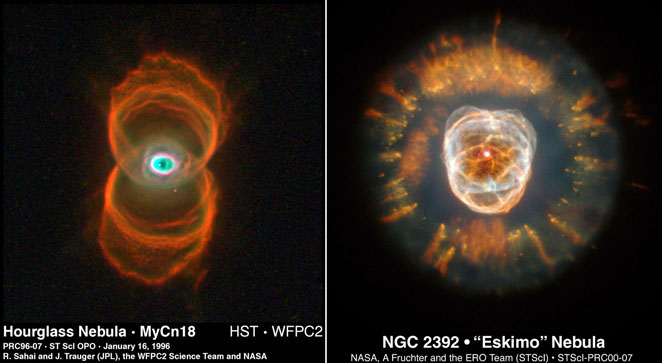
High-resolution images of planetary nebulae show complex structures in the expanding nebula. The picture below is a detailed view of the Helix Nebula from the Hubble Space Telescope. The expanding gas from the planetary nebula gas ejection runs into gas and dust dispersed in the red giant winds. As it passes the slower moving red giant wind material, the gas shapes the denser blobs into comet-like shapes. Although they are called "comet knots", they are not to be confused with real comets in our solar system. Each of these blobs is over twice the size of our entire solar system!

Further explanation of the causes of the sometimes bizarre shapes of the planetary nebula is available at Bruce Balick's homepage.
The rare high-mass stars (those with masses of about 8 to 50 times the Sun's mass during their main sequence stage) will go the explosive supernova route. When a massive star's iron core implodes, the protons and electrons fuse together to form neutrons and neutrinos. The core, once the size of the Earth, becomes a very stiff neutron star about the size of a small town in less than a second. The collapsing outer layers hit the core and heat up to billions of degrees from the impact. Enough of the huge number of neutrinos produced when the core collapses interact with the gas in the outer layers, helping to heat them up. During the supernova outburst, elements heavier than iron are produced as free neutrons produced in the explosion rapidly combine with heavy nuclei to produce heavier and very rare nuclei like gold, platinum, uranium among others. This happens in about the first 15 minutes of the supernova. The most massive stars may also produce very powerful bursts of gamma-rays that stream out in jets at the poles of the stars at the moment their cores collapse to form a black hole (source of the long gamma-ray bursts---we see only the jets pointed towards us).
The superheated gas is blasted into space carrying a lot of the heavy elements produced in the stellar nucleosynthesis process. This explosion is a supernova. As the expanding gas crashes into the surrounding interstellar gas at thousands of kilometers/second, the shock wave heats up the interstellar gas to very high temperatures and it glows. Strong emission lines of neutral oxygen and ionized sulfur distinguish their spectra from planetary nebulae and H II regions. Also, the ratio of the strengths of the individual doubly-ionized oxygen is that expected from shock-wave heating. Planetary nebulae and H II regions are lit up by the action of ultraviolet light on the gas, while supernova glow from shock-wave heating. The gas from supernova explosions also has strong radio emission with a non-thermal continuous spectrum that is produced by electrons spiraling around magnetic field lines. Gas from recent explosions (within a few thousand years ago) are visible with X-ray telescopes as well.
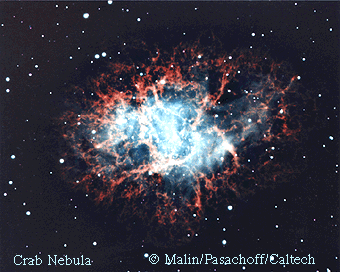
A famous supernova remnant is the Crab Nebula above. Chinese astronomers recorded the explosion on July 4, 1054 and the Anasazi Indians painted at least one picture of it. The Vela supernova (in the constellation Vela; figure below) occurred long before the Crab Nebula so it is much more spread out. Different parts of the expanding gas have run into regions of the interstellar medium of different densities. For that reason and also because there is turbulence in the expanding supernova gas, the remnant seen today is wispy strands of glowing gas.
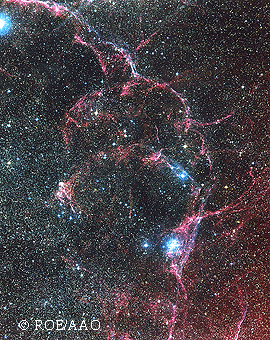
The neutrinos formed when the neutron core is created fly away from the stiff core, carrying most of the energy (over 99%) from the core collapse away with them. Some energy (less than 1%) goes into driving the gas envelope outward. The rest of the energy (less than only 0.01%) goes into making the supernova as bright as 1011 Suns (as bright as an entire galaxy)! When a supernova occurred in a satellite galaxy of the Milky Way at the beginning of 1987 (called SN1987a), the Kakiomande neutrino detector in Japan detected a huge burst of neutrinos from the direction of the satellite galaxy. This provided confirmation of the supernova models. The images below show the star before it went supernova (right frame and arrow) and after the explosion (left frame)
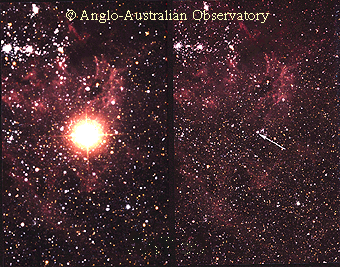
Recent views of SN1987a from the Hubble Space Telescope (below) shows the material from the supernova explosion itself expanding outward at over 9.5 million kilometers per hour preferentially into two lobes that are roughly aligned with the bright central ring. The central bright ring and two outer rings are from material ejected by the star before its death. Does this image remind you of the Hourglass Nebula above? See also the page showing the changes in the central ring.
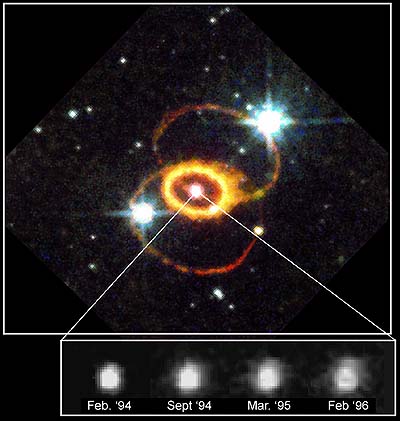
Supernovae are very rare---about one every hundred years in any given galaxy---because the stars that produce them are rare. However, there are billions of galaxies in the universe, so simple probability says that there should be a few supernovae happening somewhere in the universe during a year and that is what is seen! Because supernovae are so luminous and the energy is concentrated in a small area, they stand out and can be seen from hundreds of millions of light years away.
The bright gas nebula of a planetary nebula or supernova does not last long, only a few tens of thousands of years. As the nebula expands, it cools and dims. The processed material becomes part of the interstellar medium in the galaxy.
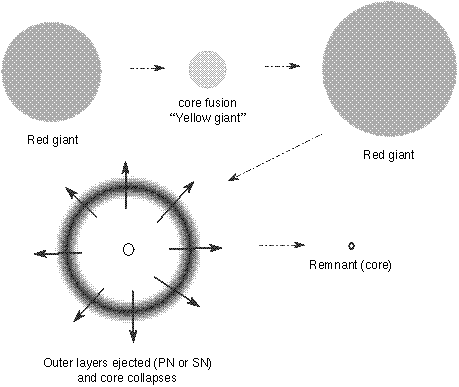
If the core has a mass between 1.4 and 3 solar masses, the neutrons will bump up against each other to form a degenerate gas in a neutron star about the size of small city. The neutrons prevent further collapse of the core. Nothing can prevent the highest mass cores (greater than 3 solar masses) from collapsing to a point. On the way to total collapse, it may momentarily create a neutron star and the resulting supernova rebound explosion and powerful bursts of gamma-rays in bipolar jets (probably the source of the long gamma-ray burst objects). Gravity finally wins. Nothing holds it up. The gravity around the collapsed core becomes so great that Newton's law of gravity becomes inadequate and the gravity must be described by the more powerful theory of General Relativity developed by Albert Einstein. This will be discussed further below.
The super-compact point mass is called a black hole because the escape velocity around the point mass is greater than the speed of light. Since the speed of light is the fastest that any radiation or any other information can travel, the region is totally black. The distance at which the escape velocity equals the speed of light is called the event horizon because no information of events occurring inside the event horizon can get to the outside. The radius of the event horizon in kilometers = 3 × core mass in solar masses.
![]() Go back to previous section --
Go back to previous section --
![]() Go to next section
Go to next section
last updated: June 24, 2022